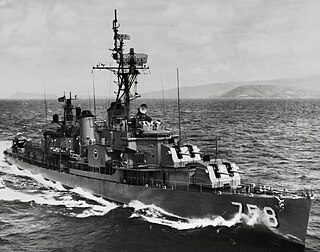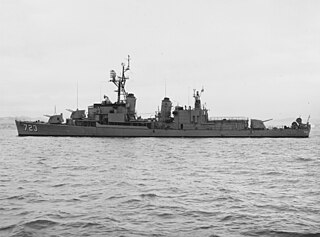
USS Arnold J. Isbell (DD-869), a Gearing-class destroyer, was the only ship of the United States Navy to be named for Arnold J. Isbell, an aircraft carrier captain during World War II. The ship was laid down on 14 March 1945 at Staten Island, New York, by Bethlehem Mariners Harbor, launched on 6 August 1945 and commissioned on 5 January 1946. Constructed too late to see action in World War II, the vessel initially served as a training ship with the United States Atlantic Fleet, before transferring to the Pacific and deploying to Korea during the Korean War and off the Vietnam coast during the Vietnam War. In 1972 Arnold J. Isbell was made part of the reserve training fleet and in 1974, sold to Greece where the ship was renamed Satchouris and served with the Hellenic Navy until being sold for scrap in 2002.

USS Brinkley Bass (DD-887) was a Gearing-class destroyer in service with the United States Navy from 1945 to 1973. She was then transferred to Brazil where she served as Mariz e Barros (D-26) until 1997. The destroyer was finally sunk as a target in 2000.

The second USS Henry W. Tucker (DD-875) was a Gearing-class destroyer of the United States Navy.

USS Higbee (DD/DDR-806) was a Gearing-class destroyer in the United States Navy during World War II. She was the first U.S. warship named for a female member of the U.S. Navy, being named for Chief Nurse Lenah S. Higbee (1874–1941), a pioneering Navy nurse who served as Superintendent of the U.S. Navy Nurse Corps during World War I.

USS Collett (DD-730) was a World War II-era Allen M. Sumner-class destroyer in the service of the United States Navy.

USS Leonard F. Mason (DD-852) was a Gearing-class destroyer in the United States Navy. She was named for Private First Class Leonard F. Mason USMC (1920–1944), who was posthumously awarded the Medal of Honor for his heroism during the Battle of Guam.

USS Taussig (DD-746) was an American Allen M. Sumner-class destroyer. It was named for Edward D. Taussig, a rear admiral of the United States Navy whose career spanned over 50 years. Adm. Taussig is remembered for claiming Wake Island for the United States on 17 January 1899 while commanding the gunboat Bennington and for accepting the physical relinquishment of Guam from Spain, ending 300 years of Spanish colonial rule.

USS Strong (DD-758), an Allen M. Sumner-class destroyer, was the second ship of the United States Navy to be named for James H. Strong, a naval commander for Union forces during the American Civil War. At the Battle of Mobile Bay, he was the first to ram the Confederate ironclad Tennessee and received high commendation for his initiative and valor.

USS Walke (DD-723), an Allen M. Sumner-class destroyer, was the third ship of the United States Navy to be named for Henry A. Walke, a Rear Admiral during the Mexican–American War and the American Civil War. The third Walke (DD-723) was laid down on 7 June 1943 at Bath, Maine, by the Bath Iron Works and launched on 27 October 1943; sponsored by Mrs. Douglas Dillon. The ship was commissioned at the Boston Navy Yard on 21 January 1944.

USS Lyman K. Swenson (DD-729), an Allen M. Sumner-class destroyer, was laid down on 11 September 1943 by Bath Iron Works, Bath, Maine and launched on 12 February 1944; sponsored by Miss Cecelia A. Swenson, daughter of Captain Swenson. The ship was commissioned at Boston Navy Yard on 2 May 1944.

USS Alfred A. Cunningham (DD-752), an Allen M. Sumner-class destroyer, is the only ship of the United States Navy to be named for Alfred Austell Cunningham, a USMC officer and aviator.

USS John A. Bole (DD-755), was an Allen M. Sumner-class destroyer of the United States Navy.

USS Wiltsie (DD-716) was a Gearing-class destroyer in the United States Navy. She was named for Irving Wiltsie. The destroyer entered service in 1946 and remained active with the United States Navy until 1977, when Wiltsie was decommissioned and sold to Pakistan in 1977. The vessel entered service with the Pakistan Navy as PNS Tariq (D165) in 1978. In 1990, the ship was renamed PNS Nazim to allow the name Tariq to be given to a newly-acquired Type 21 frigate. The ship was then transferred to the Pakistan Maritime Security Agency and used as an alongside "at sea" headquarters for the agency. Though afloat, the vessel no longer sails.

USS Theodore E. Chandler (DD-717) was a Gearing-class destroyer in the United States Navy during the Korean War and the Vietnam War. She was named for Theodore E. Chandler.

USS Hollister (DD-788) was a Gearing-class destroyer of the United States Navy, named for the three Hollister brothers, who were killed in 1943 while serving in the Navy during World War II.

USS Rupertus (DD-851) was a Gearing-class destroyer of the United States Navy, named for United States Marine Corps Major General William H. Rupertus (1889–1945).

USS Henderson (DD-785) was a Gearing-class destroyer of the United States Navy, the second Navy ship of that name, and the first named for United States Marine Corps Major Lofton R. Henderson. The previous Henderson was named for Marine Corps Commandant Archibald Henderson.

USS Benner (DD/DDR-807) was a Gearing-class destroyer of the United States Navy, named for Marine Second Lieutenant Stanley G. Benner (1916–1942), who was killed during the Battle of Guadalcanal.

USS Bausell (DD-845) was a Gearing-class destroyer in the United States Navy during the Korean War and the Vietnam War. She was named for Marine Corporal Lewis K. Bausell (1924–1944), who was awarded the Medal of Honor posthumously for "conspicuous gallantry" during the Battle of Peleliu.

The fourth USS Worden (DLG/CG-18), a Leahy-class cruiser, was a ship of the United States Navy named in honor of Admiral John L. Worden. Originally called a "destroyer leader" or frigate, in 1975 she was redesignated a cruiser in the Navy's ship reclassification. The ship entered service in 1963 and participated in the Vietnam War.




















